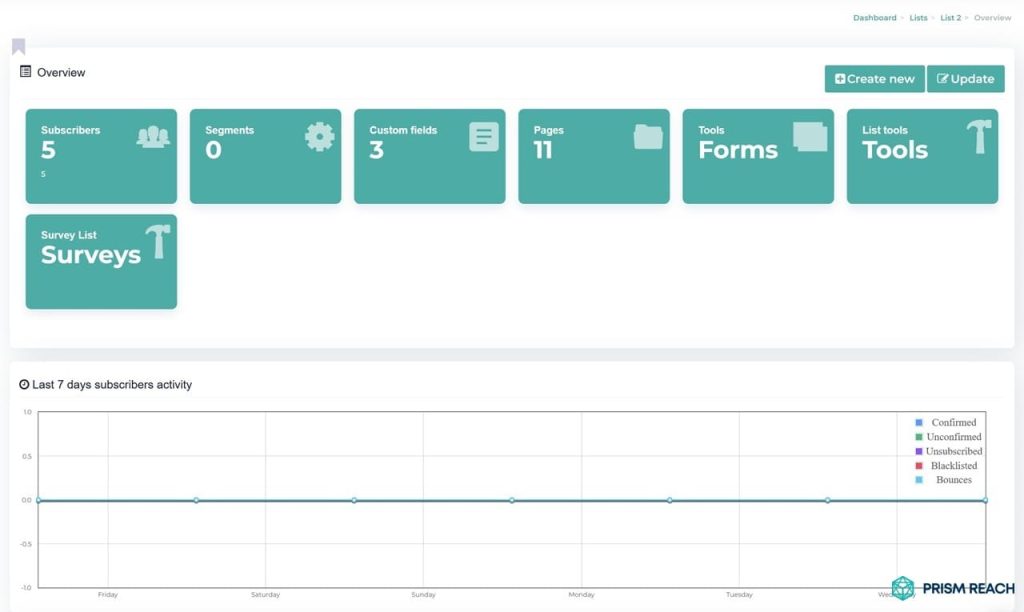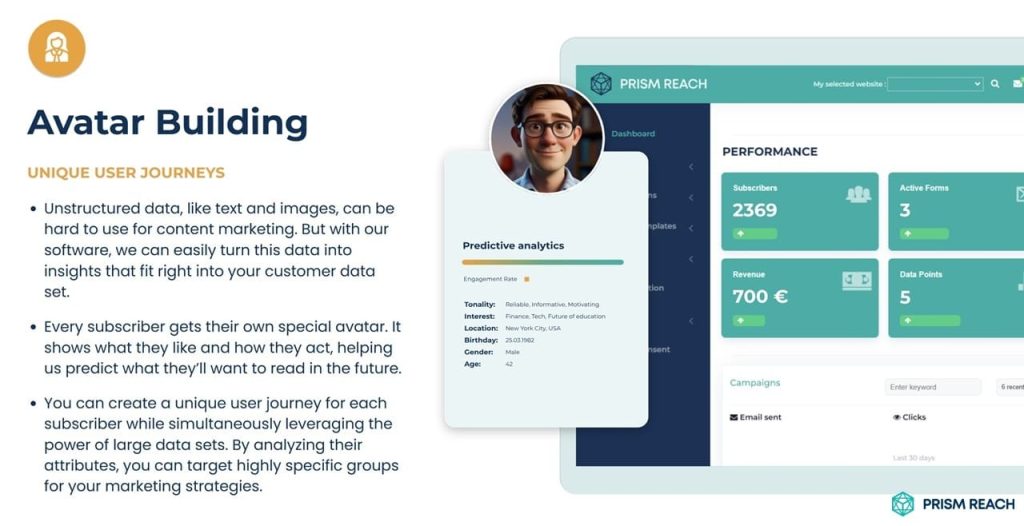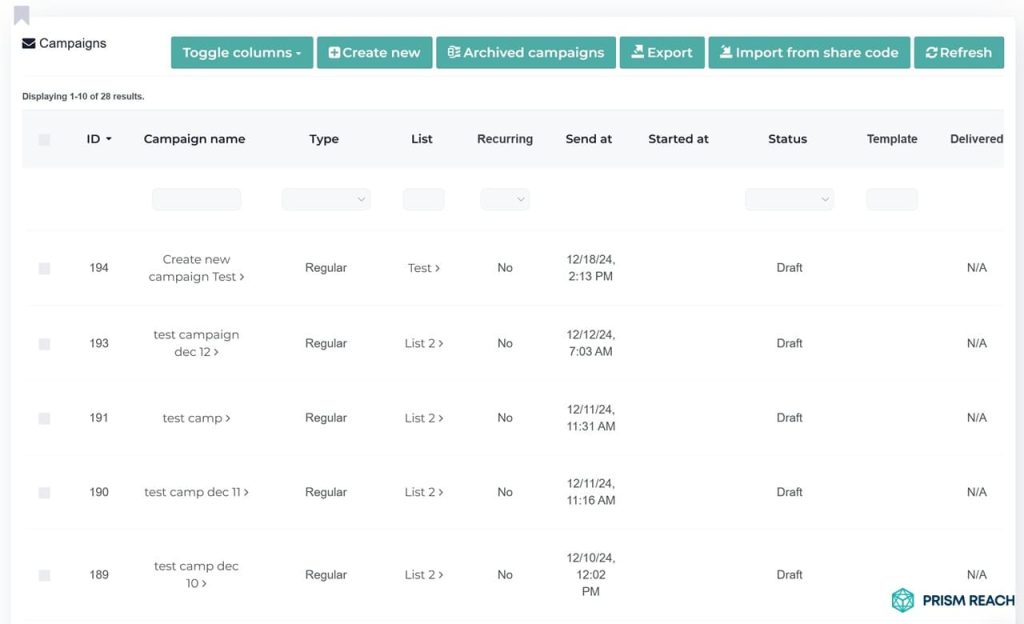In today’s digital landscape, email marketing remains a cornerstone of effective customer engagement and business growth. As we navigate through 2025, the importance of crafting successful email campaigns has never been more crucial. With the average ROI for email marketing standing at $36 for every $1 spent, according to Litmus, it’s clear that this channel continues to outperform many other marketing strategies.
However, the key to unlocking this potential lies in building campaigns that resonate with your audience and drive meaningful action. In an era where personalization and AI-driven insights are reshaping the marketing landscape, understanding how to build a successful email marketing campaign is essential for businesses of all sizes. Additionally, innovative solutions like Prism Reach are emerging to complement these strategies, offering specialized tools for deep personalization and enhanced engagement.
Key Facts
- Successful email marketing campaigns hinge on personalization, with personalized emails delivering 6x higher transaction rates.
- According to Campaign Monitor, segmented campaigns can lead to a 760% increase in revenue.
- Mobile optimization is crucial, with 81% of emails being opened on mobile devices, highlighting the need for responsive design in campaign success.
- Implementing advanced strategies like hyper-personalization and behavioral triggers can significantly enhance campaign effectiveness.
- Leveraging AI-powered tools such as Prism Reach can lead to higher engagement and improved deliverability.

Building Your Email Marketing Campaign: A Strategic Approach
The foundation of a successful email marketing campaign lies in a well-thought-out strategy that aligns with your business goals and audience needs. “The most effective campaigns start with a clear understanding of who you’re talking to and what you want to achieve,” says Jane Doe, Email Marketing Strategist at Digital Trends Inc.
1. Define and Segment Your Target Audience
To begin, define your target audience with precision. Utilize data analytics to segment your subscribers based on demographics, behavior, and preferences. This segmentation allows for tailored content that speaks directly to each group’s interests and needs. By understanding your audience deeply, you can create more relevant and engaging email campaigns. Consider factors such as age, location, purchase history, and engagement levels when segmenting your list. This approach enables you to deliver personalized content that resonates with each subscriber, increasing the likelihood of engagement and conversion.
2. Craft Compelling and Valuable Content
Next, focus on crafting compelling content. Your emails should provide value, whether through informative articles, exclusive offers, or personalized recommendations.
“Content is king in email marketing,” notes John Smith, Content Director at Email Experts LLC. “Every email should answer the question ‘What’s in it for me?’ from the subscriber’s perspective.” Ensure that your content is not only informative but also engaging and relevant to your audience’s interests. Use a mix of text, images, and calls-to-action to create visually appealing and easy-to-read emails. Remember to maintain a consistent brand voice and style across all your communications.
3. Optimize Technical Aspects and Implement Automation
Equally important is the technical aspect of your campaign. Ensure your emails are mobile-responsive, as a significant portion of users access emails on their smartphones. Pay attention to subject lines, using A/B testing to determine what resonates best with your audience. Additionally, implement automation to send timely, relevant messages based on subscriber actions or milestones. This could include welcome series for new subscribers, birthday emails, or re-engagement campaigns for inactive users. Automation helps maintain consistent communication with your audience while saving time and resources.

4. Monitor, Analyze, and Refine Your Strategy
Monitoring and analyzing your campaign’s performance is crucial for ongoing success. Track key metrics such as open rates, click-through rates, and conversion rates. Use these insights to refine your strategy continually, adapting to changing subscriber preferences and market trends. Regularly review your campaign data to identify what’s working well and areas for improvement. This could involve adjusting your content strategy, refining your segmentation, or tweaking your send times. By consistently analyzing and optimizing your campaigns, you can ensure that your email marketing efforts remain effective and continue to drive results for your business.
5. Leverage Personalization for Higher Engagement
Personalization is a key factor in building successful email marketing campaigns. As mentioned in the key facts, personalized emails can deliver 6x higher transaction rates. This goes beyond simply using the subscriber’s name in the email. Utilize the data you’ve gathered through segmentation to tailor the content, offers, and even the timing of your emails to individual preferences. Consider using dynamic content that changes based on the recipient’s past behavior or stated interests. By making each email feel personally relevant to the subscriber, you can significantly increase engagement and conversion rates.
6. Ensure Mobile Optimization
With 81% of emails being opened on mobile devices, as stated in the key facts, mobile optimization is crucial for the success of your email marketing campaign. Ensure that your emails are responsive and look great on all screen sizes. This includes using a mobile-friendly layout, legible fonts, and appropriately sized images. Test your emails on various devices and email clients to ensure they display correctly. Consider using a single-column layout for easy scrolling on mobile devices. Buttons and links should be large enough to be easily tapped with a finger. By prioritizing mobile optimization, you can improve the user experience for a majority of your subscribers, leading to higher engagement rates.
7. Implement A/B Testing for Continuous Improvement
A/B testing, or split testing, is a powerful tool for refining your email marketing campaigns. As mentioned in the original text, this technique is particularly useful for optimizing subject lines. However, it can be applied to various elements of your emails. Test different versions of your email content, layouts, call-to-action buttons, or send times with a small portion of your list before sending to the entire audience. Analyze the results to determine which version performs better in terms of open rates, click-through rates, or conversions. Use these insights to continually improve your campaigns. Remember, even small improvements can lead to significant results when applied consistently across your email marketing efforts.
Hidden Gems: Enhancing Your Campaign with Advanced Strategies
While mastering the fundamentals and advanced techniques is crucial, integrating lesser-known strategies can provide significant advantages. Here are five hidden gems that can enhance your effectiveness in building a successful email marketing campaign:
1. Implement Progressive Profiling
Strategy: Use progressive profiling to gather information about subscribers gradually, rather than asking for all details upfront.
Potential Effectiveness: This approach increases the likelihood of sign-ups and allows for more personalized content over time as you learn more about your audience.
Level of Obscurity: High; many marketers still rely on traditional forms that ask for too much information at once.
Ease of Implementation: Moderate; requires setting up forms that adapt based on user interactions but is manageable with most email platforms.
Uniqueness: Creates a more engaging experience by making the sign-up process less daunting and more tailored.
Steps to Implement Progressive Profiling:
- Start with a minimal signup form requesting only essential information (e.g., email address).
- As subscribers engage with your emails, gradually ask for more information (e.g., name, preferences, interests).
- Use this data to segment your audience and personalize future communications.
- Ensure that the process feels seamless and not intrusive to maintain subscriber trust.
2. Leverage Behavioral Triggers
Strategy: Set up automated emails based on user behavior, such as browsing history, cart abandonment, or previous purchases.
Potential Effectiveness: This can significantly increase conversion rates by sending timely and relevant messages that prompt action.
Level of Obscurity: Moderate; while automation is common, the specific use of behavioral triggers is often underutilized.
Ease of Implementation: Easy; most email marketing platforms have built-in automation features for this purpose.
Uniqueness: Offers a personalized touch that can enhance customer relationships and drive sales.
Examples of Behavioral Triggers:
- Cart Abandonment: Send reminders to users who have left items in their cart.
- Browse Abandonment: Engage users who have browsed specific products but haven’t made a purchase.
- Post-Purchase Follow-Up: Thank customers for their purchase and suggest related products.
- Re-Engagement: Target inactive subscribers with special offers to revive their interest.
3. Create Interactive Emails
Strategy: Incorporate interactive elements like polls, surveys, or GIFs within your emails to engage recipients actively.
Potential Effectiveness: Interactive content can lead to higher engagement rates as it encourages recipients to participate rather than passively read.
Level of Obscurity: High; while some brands use interactive content, it’s still not widely adopted in email marketing.
Ease of Implementation: Moderate; requires knowledge of HTML/CSS or using platforms that support interactive features.
Uniqueness: Provides a fresh approach to email marketing that can differentiate your campaigns from competitors.
Types of Interactive Elements:
- Polls and Surveys: Gather feedback or insights directly from your subscribers.
- Animated GIFs: Add visual interest and convey messages dynamically.
- Image Carousels: Allow users to scroll through multiple images within the email.
- Accordion Menus: Enable recipients to expand sections for more information without leaving the email.
4. Focus on Storytelling
Strategy: Use storytelling techniques in your emails to create emotional connections with your audience and convey your brand message effectively.
Potential Effectiveness: Engaging narratives can lead to higher open rates and click-through rates as they resonate more deeply with readers.
Level of Obscurity: Moderate; while storytelling is common in content marketing, its application in email campaigns is often overlooked.
Ease of Implementation: Easy; requires creativity but can be integrated into existing content strategies without significant changes.
Uniqueness: Helps build a strong brand identity and fosters loyalty among subscribers by creating memorable experiences.
Storytelling Techniques for Emails:
- Start with a compelling hook to grab attention.
- Develop a narrative that aligns with your brand values.
- Use real-life examples or customer stories to add authenticity.
- Incorporate a clear call-to-action that ties into the story.

5. Use AI-Powered Content Generation
Strategy: Leverage AI tools to assist in generating subject lines, body copy, or even entire emails based on best practices and data-driven insights.
Potential Effectiveness: AI can help save time while producing high-quality content tailored to audience preferences, improving engagement rates.
Level of Obscurity: Moderate; while AI tools are becoming popular, their specific application in email marketing is still emerging.
Ease of Implementation: Easy; many platforms offer integrated AI features that require minimal setup.
Uniqueness: Positions you at the forefront of technology adoption in marketing practices.
Benefits of AI-Powered Content Generation:
- Generates optimized subject lines to increase open rates.
- Creates personalized content based on subscriber data.
- Enhances efficiency by automating repetitive writing tasks.
Integrating Hidden Gems into Your Strategy
To fully leverage the capabilities of Zendesk, HubSpot, SendGrid, Mailchimp, and Prism Reach, consider integrating these hidden gems into your email marketing strategy. Here are some practical ways to do so:
- Implement Progressive Profiling: Use Prism Reach’s AI-driven tools to gradually gather subscriber information, enhancing personalization without overwhelming new sign-ups.
- Leverage Behavioral Triggers: Set up automated workflows in HubSpot or SendGrid that respond to user behavior, utilizing Prism Reach’s data insights for precise targeting.
- Create Interactive Emails: Utilize Mailchimp’s interactive features combined with Prism Reach’s dynamic content selection to design engaging and responsive emails.
- Focus on Storytelling: Craft compelling narratives using Prism Reach’s content generation capabilities to create memorable and impactful email stories.
- Use AI-Powered Content Generation: Enhance your email content with Prism Reach’s AI tools to produce personalized and optimized messages effortlessly.
Practical Tips for Maximizing Your Email Marketing
To fully leverage the capabilities of Zendesk, HubSpot, SendGrid, Mailchimp, and Prism Reach, consider the following practical tips:
- Leverage AI-Powered Personalization: Use Prism Reach’s AI-driven content recommendations to enhance the personalization features in Zendesk and HubSpot, ensuring that each subscriber receives content that resonates with their preferences.
- Optimize Send Times: Utilize Prism Reach’s predictive analytics to determine the optimal times to send newsletters, maximizing subscriber engagement and open rates.
- Automate Workflow Processes: Implement SendGrid’s API integrations or HubSpot’s automation workflows to automate complex processes, reducing manual effort and ensuring timely communication with leads.
- Integrate Comprehensive Reporting: Combine the reporting capabilities of Zendesk or HubSpot with Prism Reach’s detailed engagement metrics to gain a holistic view of campaign performance and make data-driven decisions.
- Enhance Lead Qualification: Use advanced segmentation models in HubSpot alongside Prism Reach’s user avatars to prioritize high-potential leads, improving engagement and conversion rates.
By integrating these tips into your marketing strategy, you can create a more cohesive and effective approach that leverages the strengths of each platform and tool, ultimately driving better results and higher ROI.
Innovative Solutions by Prism Reach
While mastering the fundamentals and advanced techniques is crucial, integrating innovative solutions can significantly enhance your email marketing efforts. Prism Reach emerges as a cutting-edge player in this space, offering AI-powered personalization that takes email marketing to the next level.
Benefits of Prism Reach:
- Enhanced Personalization: Prism Reach’s AI-driven personalization helps in implementing hyper-personalization techniques, leading to higher engagement rates.
- Improved Deliverability: Prism Reach’s anti-spam checks and deliverability optimizations ensure that emails reach the inbox, supporting best practices to avoid spamming.
- Data-Driven Insights: Prism Reach provides analytics and insights that help in refining email strategies, including feedback loops and engagement tracking.

How Prism Reach Enhances Your Email Marketing:
- AI-Powered Personalization: Uses sophisticated algorithms to tailor content to each subscriber’s preferences and behaviors.
- Dynamic Content Selection: Automatically adjusts email content based on real-time data, ensuring relevance and engagement.
- Advanced Anti-Spam Checks: Incorporates anti-spam technologies to maintain a strong sender reputation and high deliverability rates.
Prism Reach’s core functionality revolves around its proprietary AI technology, which clusters website content and social media posts into relevant categories. This AI uses a variety of data points to create detailed user avatars, enabling personalized newsletter content that incorporates factors such as location, engagement history, and predicted interests. The system’s ability to analyze vast amounts of data allows for highly targeted marketing strategies, complementing the broader automation capabilities of Zendesk and HubSpot.
Upgrade Your Email Marketing with AI Personalization!
Conclusion
Building a successful email marketing campaign in 2025 requires a blend of strategic thinking, creative content, and technological innovation. By focusing on personalization, segmentation, and data-driven insights, you can create campaigns that not only reach your audience but truly resonate with them. Remember, the key to success lies in continuous optimization and a willingness to adapt to changing consumer preferences and technological advancements.
As email marketing continues to evolve, embracing tools like Prism Reach can give you a competitive edge, allowing you to deliver highly personalized experiences that drive engagement and conversions. By implementing these strategies and leveraging cutting-edge technology, you’ll be well-positioned to create email marketing campaigns that deliver real results for your business.
Sources
- Stripo. (n.d.). Unconventional Email Marketing Campaigns. Retrieved from https://stripo.email/blog/unconventional-email-marketing-campaigns-that-make-your-brand-stand-out/
- Tweak Your Biz. (n.d.). Offbeat Email Marketing Strategies. Retrieved from https://tweakyourbiz.com/posts/10-offbeat-email-marketing-strategies-that-you-might-want-to-try-in-2022
- Selzy. (n.d.). Creative Marketing Emails. Retrieved from https://selzy.com/en/blog/really-weird-emails/
- ConvertCart. (n.d.). Unconventional Email Marketing Ideas. Retrieved from https://www.convertcart.com/blog/email-marketing-ideas-for-ecommerce
- HubSpot. (n.d.). Email Marketing Statistics. Retrieved from https://blog.hubspot.com/marketing/email-marketing-statistics